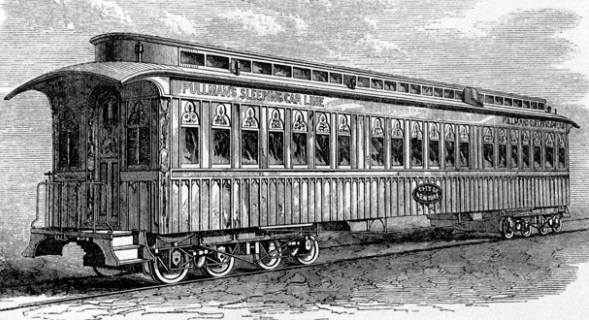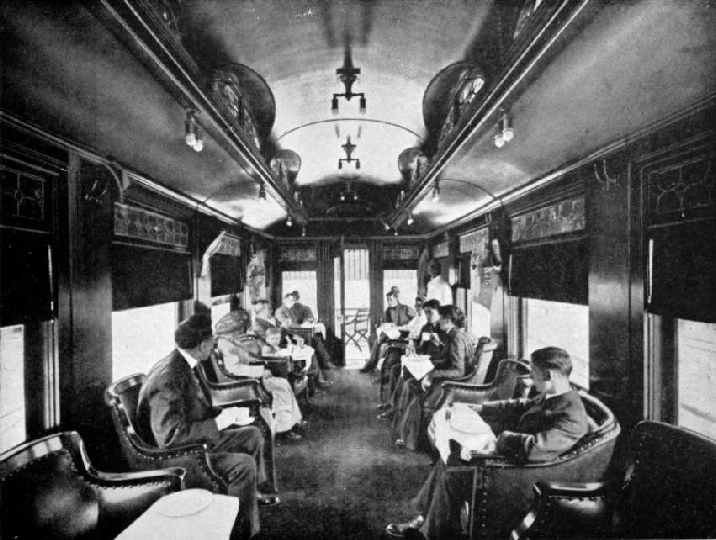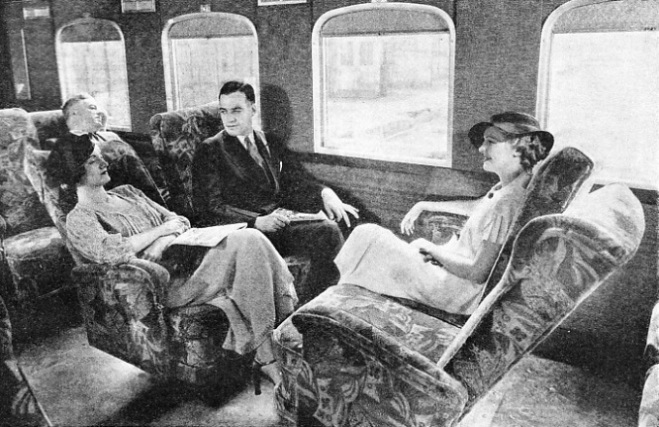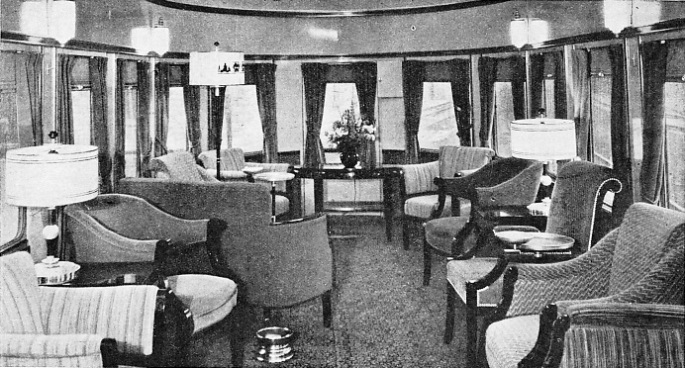
© Railway Wonders of the World 2012-


The North American Railway Carriage
The Development of the Passenger Car in North America

One of the early Pullman sleeping cars of 1869
THE North American railway carriage or passenger car has for many years offered the ordinary passenger standards of comfort which he will look for in vain in any other field of public transport. As in Britain, the earliest carriages on rails were but developments of the highway coach -
As the American railroad network grew, journeys of 24 hours or more became commonplace (speeds were not high) and the need for a vehicle which made provision for both day and night travel became clear. Economy required that such a vehicle should be convertible and from a number of early designs, that of George Mortimer Pullman became most widely adopted. In the Pullman layout, groups of four seats (two facing pairs) on each side of the aisle could, by rearrangement of the cushions and backs, be made into a bed, or lower berth. An upper berth was built into the upper wall and ceiling panelling and could be lowered when required; privacy was achieved by heavy curtains. Toilet facilities were provided at the car ends.
American railways, with little traffic offering in early days, had to be cheaply built and high-
Heating was by stove, one or sometimes two to a car, and using wood, coal or occasionally oil as a fuel. Lighting developed from oil, through gas to electricity. Seats in ordinary coaches were often reversible (“walkover”) and plush finished, although rattan was sometimes used for shorter journeys. Windows generally were narrow and could be opened upwards, to admit (in summer) a cooling draught -
The early car bodies were mainly of wood construction but increasing size of vehicles and emphasis on greater safety led first, in the latter part of the 19th century, to the steel underframe and eventually, in late Edwardian times, to the all-
As car design developed, meeting the needs of an expanding, prosperous nation, details improved. The open-
A feature of American rail travel (to European eyes) is the door opening ceremony performed by trainmen, who also assist passengers joining or alighting from trains. Both halves of the door are swung inwards while the train is slowing, the trap is lifted and clipped up, the handrail is wiped clean of dust with a paper towel after the trainman has descended to the bottom step, with the stepping stool ready, and finally, as the train stops, the stool is placed on the ground beside the steps.
By late Victorian times, a considerable degree of comfort was provided. Dining cars had replaced station meal stops, so reducing journey time, and both dining and sleeping cars were ornately decorated, in keeping with the times, with a high degree of craftsmanship used in decorative woodwork of various styles. Electric light was coming into use, and the Westinghouse air brake, adopted earlier, improved not only safety but comfort in stopping. Car lengths had increased from the early 50 or 60 ft to 70 to 75 ft. The larger and heavier cars often rode on two 6-

A library-
The ornate finish was not confined to interiors. Externally, dark green was, perhaps, the most common livery, and “tuscan” red was used by a number of companies, including, up to the last few years, the Pennsylvania, and Canadian Pacific. The railway’s name appeared along the “letter board” above the windows, commonly in gold leaf and usually in an extended Roman script, with serifs. Car sides prior to adoption of the all-
With the larger cars, windows of passenger spaces were often arched, with the upper part fitted with stained glass. An essential feature of all American passenger cars (in contrast with British practice) was the handbrake. On open-
Two classes of travel were generally provided, “coach”, that is day-
The Parlor car, provided where day-
The Edwardian period witnessed the development of the all-
This is an appropriate place to make the point that few American railroads had or have sufficient capacity to build all their own rolling stock (or, for that matter, locomotives). There is a very sizeable industry in the USA manufacturing both freight and passenger vehicles and while some railroads’ railway works (“backshops”) could, and did, manufacture locomotives or cars (the Pennsylvania built both at its Altoona, Pa, shops), outside purchase was more common.
Interworking in traffic had long made some degree of standardisation essential, and purchasing from common equipment manufacturers carried the process considerably farther, so that the 1920s became known as the Standard Era.

Comfortable travel is the keynote of the American railway service. The above photograph shows the luxurious interior of a streamlined coach built at Milwaukee for the Chicago, Milwaukee, St Paul and Pacific Railroad in 1934. This company, operating some 11,000 miles, owns about 1,200 passenger coaches, including two completely streamlined trains for high-
Use of Pullman cars was particularly influential, for the Pullman Company provided sleeping car service under contract to almost every road which required it. The Pullman fleet rose to almost 10,000 cars by 1931, and 4,000 of them were of one basic design. That was the 12-
For the 24 possible occupants of the sections, separate men’s (“smoking”) and women’s (“rest”) rooms were provided at opposite ends of the car. Each washroom contained two or three wash-
The day coach, too, might well have smoking/rest room facilities at each end, but the interior was changed only in details of the fittings; seats were still arranged in pairs on each side of the central aisle. Whereas Pullman sleepers had for years been a product of the Pullman-
It is worth looking at the make-
Next came the coaches; often one would be set aside for local passengers making short journeys, while passengers for major stations might be directed to particular coaches, thus making on-
coaches and the Pullmans came the dining car, kitchen section to rear (so that the train’s draught did not blow the heat from the kitchen back on to the diners). Then came the Pullmans and, at the rear of any train worth its salt in the nineteen-
A long-
The spread of paved roads and use of private motorcars, the practical development of commercial flying and the depression, from 1930 made heavy inroads into railway passenger business. Contraction was severe, but several developments in the early 1930s brought the internal-
Air conditioning was also applied, in the nineteen thirties, to existing Standard cars, firstly to diners, then to sleepers, and to a limited extent, to coaches. The financial position of many railways after the depression restricted investment in new stock, hence the refurbishing of older cars, which had then to meet the enormous flood of war-

A drawing room on wheels is the effect of this handsomely furnished observation lounge on the rear of the Baltimore and Ohio Railroad’s new streamlined express, the “Abraham Lincoln”, operating between Chicago and St. Louis. The express covers the 284 miles run in 5½ hours. The company, controlling some 5,550 miles, owns about 1,680 passenger coaches.
You can read more on “International Sleeping Cars”, “Modern Passenger Rolling Stock” and “The Railway Carriage” on this website.